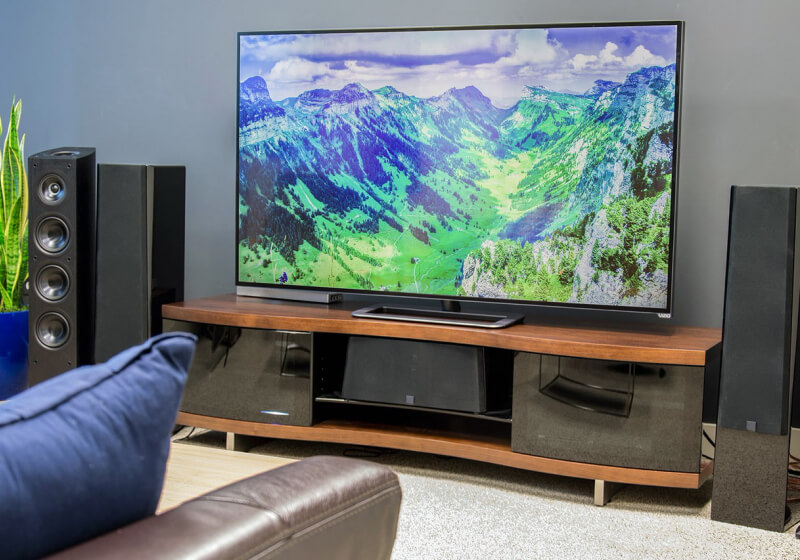If you've looked into purchasing a TV in recent years, you've been perhaps overwhelmed by the jargon and conflicting information. Indeed, there's a lot of misinformation out there, so to help you filter it out, we've debunked some commonly held beliefs about buying a TV.
Myth #1
4K TVs Are Expensive
While this statement may have been true just a few years ago, these days 4K TVs are very affordable. In fact, this past Black Friday, prices on 4K TVs were nearly as low as their 1080p counterparts. So even though we're still waiting for 4K content to become commonplace, there isn't any reason not to get a 4K TV in anticipation of when that time comes.

Myth #2
Contrast Ratio and Refresh Rate Are Important Specs
These specifications might sound like scientific measurements designed to accurately evaluate a TV's performance; however, almost the opposite is true. There are no guidelines for measuring contrast, so while a manufacturer may claim that a TV has a contrast ratio of 1-million-to-1, this number might as well as have been pulled out of thin air.
Similarly, refresh rates suffer from manufacturer manipulation. While refresh rate was developed to combat motion blur, and some TVs really do have 120Hz and maybe even 240Hz refresh rates, manufacturers have come up with their own terms that incorporate such numbers. Thus, while it may appear that a TV has a high refresh rate, it may actually just have a rate of 60Hz. CNET has a great write up about how this plays out with 4K TVs.
Myth #3
TVs With Voice Recognition Listen to Your Conversations
Although Samsung didn't do a very good job assuring people otherwise in 2015, your Smart TV isn't listening in on your personal conversations. Still, there's a much better chance that your TV viewing habits are being tracked.
While it may appear that a TV has a high refresh rate, it may actually just have a rate of 60Hz.
Myth #4
You Should Buy an Extended Warranty
According to Consumer Reports, only 4% of TVs require servicing during their first four years. As such, instead of recommending an extended warranty, CR advises buying a TV with a credit card that extends the manufacturers' warranty.
Myth #5
Curved TVs Are Better
Supposedly designed after movie theater screens, curved TVs are purported to offer a more immersive viewing experience by filling the viewer's field of vision. However, as we've explained in the past, given the size of a television, there's a very small sweet spot in which one or two people can have this experience. You're better off spending your money on a set equipped with an IPS display panel, which will allow your flat set to look good from multiple viewing angles.
Myth #6
High-End TVs Have High-End Audio
Logic would have you think that if you're a paying a premium price for a premium TV, you'd get premium audio. Not so. With thinner and lighter bezels, such TVs are physically not able to house powerful speakers. As such, if audio is important to you, you should plan on purchasing a sound bar or home theater system to go with your new TV.

Myth #7
It's Worth Paying More for a Smart TV
Buying a Smart TV has its advantages, so this statement isn't completely false. A Smart TV will allow you to go virtually wireless, and of course, will let you access content via streaming platforms like Netflix and Hulu.
Even so, you can access the same content using a streaming stick, a set-top box like an Apple TV or Roku, or your PlayStation or Xbox console. Plus, you'll likely get a more user-friendly and robust interface with these streaming devices. Even if you don't already own a streaming device, you can often get a streaming stick for less than the difference between a Smart TV and a non-Smart TV.
Myth #8
Pricey HDMI Cables Are Worth It
The greatest trick the devil ever pulled may have been convincing the world he didn't exist, but the second greatest was convincing us that pricey HDMI cables were worth the expense. All HDMI cables deliver the same information, so there's no point in buying expensive ones.
All HDMI cables deliver the same information, so there's no point in buying expensive ones.
Myth #9
All HDR Is the Same
One of the buzzwords that you've probably heard lately is HDR, or high dynamic range. As it sounds, HDR increases the contrast between the brightest whites and the darkest blacks, creating more vibrant colors in between. But even if you have an HDR TV, you'll only see the difference when watching HDR content.
There are three types of HDR, the most common being HDR10. The others are Dolby Vision and HDR10+. The difference between HDR10 and the other two is that its brightness levels are set for an entire program, while the other types allow for different settings for each scene.
Myth #10
A New TV Will Only Last a Few Years
There seems to be a prevailing thought that an HDTV will only last a few years. This appears to stem from some TVs being rated as having a life span of 30,000 hours. Though a year has 8,760 hours in it, you're not going to have your TV on the whole time. Even if your TV was on for 10 hours a day, your set's life span would be eight years.
But when a manufacturer refers to a TV's life span, that is the time until its brightness dims by half. Your TV will continue to work after such a time, just not as well. You can extend your TV's life by turning down the brightness and contrast. Plus, many sets are expected to have a life span of 60,000 hours. So there's no reason you shouldn't be able to get 10-plus years out of a TV.
Myth #11
8K Is Just Around the Corner, So Skip the 4K TV
If you've heard about 8K TVs, and have started thinking that you might as well hold off on getting a 4K TV and wait to buy an 8K set, you're going to be waiting awhile. As we've covered in depth, 8K is still a long ways from being a reality.

Stephen Slaybaugh is a Senior Staff writer at dealnews. Republished with permission.
Masthead by Jarosław Ceborski via Unsplash
